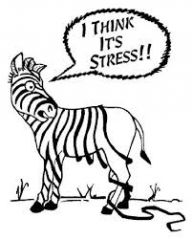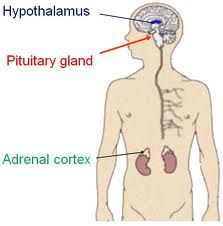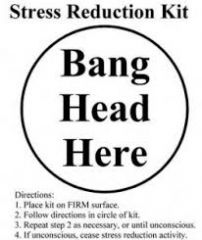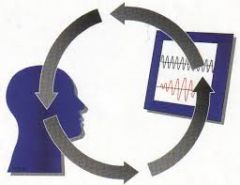![]()
![]()
![]()
Use LEFT and RIGHT arrow keys to navigate between flashcards;
Use UP and DOWN arrow keys to flip the card;
H to show hint;
A reads text to speech;
17 Cards in this Set
- Front
- Back

STRESSOR |
A stressor is any person, object, situation or event that produces stress which can come from an internal or external source. |
|
|
STRESS |
It is a state of physiological and psychological arousal produced by internal or external stressors that are perceived by the individual as challenging or exceeding their ability or resources to cope.
It is a subjective experience. |
|

PHYSIOLOGICAL AND PSYCHOLOGICAL RESPONSES TO STRESS |
A stress response is a reaction that involves the physiological (bodily) and psychological (mental) changes people experience when confronted by a stressor.
A stress response is classified into three categories. Mild stress can be exhilarating, stimulating, motivating, challenging and sometimes even desirable. For example the level of arousal that usually accompanies mild stress can enhance performance in both simple and complex tasks. Acute stress response is when a very high arousal level is produced suddenly for a relatively short time. Whereas chronic stress response produces an increased arousal level that persists over a relatively long time. |
|
|
PHYSIOLOGICAL RESPONSES TO STRESS |
Includes: -Fight-flight response -Activation of the HPA axis -Eustress and distress |
|

FIGHT-FLIGHT RESPONSE |
The fight-flight response is an involuntary reaction resulting in a state of physiological readiness to deal with a sudden and immediate threat by either confronting it or running away to safety. Changes when experiencing the fight-flight response include: -increased heart rate and blood pressure -redistribution of blood supply from the skin and intestines to the muscles -increased glucose secretion by the liver(for energy) -dilation of the pupils -suppression of some functions such asdigestion |
|

ACTIVATION OF THE HPA AXIS |
When a stressor is not removed or we need to deal with it over time, additional physiological responses are required as the body cannot maintain the intensity of the fight-flight reactions. In this case the HPA axis will be activated.
HPA axis (hypothalamic-pituitary-adrenocortical axis) involves the hypothalamus, the pituitary gland and the adrenal cortex. The hypothalamus stimulates the nearby pituitary gland which then secretes hormones such as ACTH into the bloodstream. Among other things, ACTH stimulates the adrenal cortex to secrete additional 'stress hormones' called corticosteroids. One of these hormones is called cortisol and its main effect is to energise the body(by increasing blood sugar and metabolism). The level of cortisol circulating in the bloodstream is a commonly used measure of stress by researchers.
It takes longer to activate than the fight-flight response but lasts longer. |
|

EUSTRESS AND DISTRESS |
Eustress is a positive psychological response to a stressor as indicated by the presence of positive psychological states such as feeling enthusiastic and motivated, excited, active and alert. It is typically short-term and can provide the motivation needed to achieve a goal. It isn't considered harmful to the body.
Distress is a negative psychological response to a stressor, as indicated by the presence of negative psychological states such as anger, anxiety, nervousness, irritability or tension. It can be short-term or persist over a long period of time if not addressed.
All stressors produce a non-specific stress response, which means that regardless the type of stressor (positive or negative), the body undergoes virtually the same physiological changes. |
|
|
PSYCHOLOGICAL RESPONSES TO STRESS |
Our physiological responses to stress are normally involuntary but with our psychological responses, we normally have some control over them depending on the individual. the psychological responses are divided into two categories, emotional and cognitive changes.
Emotional changes - a stressor can influence the way a person feels. When a person's emotional equilibrium is off balance following exposure to an unavoidable stressor, they often report feeling anxious, tense, depressed, angry, irritable and short-tempered.
Cognitive changes - associated with a stress response influence a person's mental abilities, such as their perceptions of their circumstances and environment, their ability to learn and how they think. Often perceptions are distorted in some way. A related phenomenon is commonly described as catastrophising, which is considered to occur when we dwell on and overemphasise the potential consequences of negative events.
Behavioural changes - are apparent in how a person looks, talks, acts and so on.
Psychological determinants of the stress response - there are factors that cause or influence the human stress response which includes: -prior experience with stressors and stress responses -attitudes -motivation -level of self-esteem -general outlook on life (optimism/pessimism) -personality characteristics -coping skills -perception of how much control we have over a stressful situation or event |
|

LAZARUS AND FOLKMAN'S TRANSACTIONAL MODEL OF STRESS AND COPING |
This model focuses on two key psychological factors that determine the extent to which an event is experienced as stressful: -the meaning of the event to the individual -the individual's judgement of their ability to cope with it
The transactional model of stress and coping proposes that stress involves an encounter (transaction) between an individual and their external environment, and that a stress response depends upon the individual's interpretation (appraisal) of the stressor and their ability to cope with it.
TYPES OF APPRAISAL Primary appraisal - we evaluate or judge the significance of the situation. The outcome of a primary appraisal is a decision about whether the situation is irrelevant, can be positive or stressful. If we decided that the situation is stressful, then we engage in additional appraisals: -harm/loss - involves an assessment of how much damage has already occurred -threat - involves an assessment of harm/loss that may not yet have occurred but could occur in the future -challenge - involves and assessment of the potential for personal gain or growth from the situation Secondary appraisal - we evaluate our coping options and resources and our options for dealing with the stressful situation. The coping options may be internal (determination) or external (family). Reappraisal - we determine the extent to which additional resources are needed to cope with the situation which involves: -reappraising the situation while taking account of the coping resources that are available -reappraising the coping resources while taking account of the reappraised threat
COPING STRATEGIES Coping - is the process of constantly changing cognitive and behavioural efforts to manage specific internal and/or external stressors that are appraised as taxing or exceeding the resources of the person.(managing the demands of a stressor in some effective way) Problem focused coping - involves efforts to manage or change the cause or source of the stress which may include: -examining the stressor from new perspectives -obtaining more information about the stressor by talking to someone who could help -redefining the stressor in a way that is more manageable -finding alternative ways of dealing with the stressor -focusing on changing only what is changeable -learning new skills to effectively manage the stressor Emotion focused coping - involves efforts to deal with our emotional response to the stressor. These strategies includes efforts such as: denial, distancing, avoiding, minimising, wishful thinking, acceptance, venting emotions and seeking emotional support from family members and friends. |
|
|
STRENGTHS AND LIMITATIONS OF THE TRANSACTIONAL MODEL |
STRENGTHS -it focuses on psychological determinants of the stress response over which we do have control and emphasises the personal nature and individuality of the stress response. -it shows the individual in an active role and emphasises their role in interpreting what the situation means to them which allows more variability in the human stress response and why people react differently to stressors. -having reappraisals, allows the fact that stressors and the circumstances can change over time which changes our perception about a stressor and its impact on us. -proposes different methods for stress management strategies.
LIMITATIONS -difficult to test this model through experimental research as it is very subjective. -primary and secondary appraisals can occur simultaneously which makes it difficult to isolate and study. -you don't always appraise something to experience stress. |
|
|
SOCIAL, CULTURAL AND ENVIRONMENTAL FACTORS THAT INFLUENCE THE STRESS RESPONSE |
Social factors that can influence the stress response include our relationships and social interactions with others. Social readjustment - refers to the amount of change, or adjustment in lifestyle a person is forced to make following a specific event in their life.
Cultural factors - changing to a different society can be stressful. Acculturative stress refers to the stress people experience in trying to adapt to a new culture.
Environmental factors that can influence the stress response include crowding, loud noise, air pollution, extremes of temperature and catastrophes such as technological and natural disasters. Crowding is one of the first environmental factors influencing the stress response to be studied through experimental research. It refers to the feeling of being cramped, of having less space than preferred. It is a subjective experience. The effects of crowding on the human stress response in real life depend on both the situation and the individual involved, for example, factors such as: -length of time spent in a high density situation -individual's personal characteristics -individual's perception of whether a situation is constricting -individual's sense of personal control over the situation |
|

ALLOSTASIS |
Allostasis refers to the body's ability to maintain a stable physiological environment by adjusting and changing to meet internal and external demands. It helps the body achieve stability by changing.
Homeostasis is the body's ability to maintain a stable physiological environment by keeping certain bodily conditions constant. It helps the body achieve stability by staying the same.
Allostatic systems act to protect the body by responding to internal and external stimuli which include the HPA axis, the ANS, immune, cardiovascular and metabolic systems.
Allostatic load refers to the cumulative negative effects of the wear and tear of the body and brain experience due to repeated cycles of allostatic changes and/or the inefficient turning on and turning off these responses.
Allostasis and the biopsychosocial framework The allostatic model acknowledges that all types of factors within the individual and in their external environment are potential stressors and that the individual's lifestyle can alleviate or worsen the stress response and lead to allostatic load. The model also emphasises the crucial role of the brain's perceptions of what is a stressor and in regulating the body's response to stress. for example our perception or appraisal (psychological factor) of a potential stressor (biological, psychological or social factor0 will determine whether the HPA axis and systems involved in an allostatic response are activated (biological factor). |
|
|
STRATEGIES FOR COPING WITH STRESS |
They include: -biofeedback -meditation and relaxation -physical exercise -social support |
|

BIOFEEDBACK |
Biofeedback - is a technique that enables an individual to receive information (feedback) about the state of a bodily process (bio). With appropriate training, the individual can learn to control a related physiological response using thought processes.
During biofeedback training, electrical or mechanical sensors, like electrodes used on the EEG or a blood pressure cuff, are attached to the person. These sensors respond to a particular physiological response and the signals that are detected are then analysed and displayed either visually or in a auditory form, to provide the person with information about the state of a relevant bodily process. The person is then taught a series of physical and mental exercises designed to help them learn how to gain control over the physiological response that is being monitored.
A common criticism is that even though it is successful in a clinic, its effects don't always last after the clinic. |
|

MEDITATION AND RELAXATION |
Meditation - is a specific technique that involves altering one's state of consciousness by focusing attention or thoughts on a single internal stimulus.
When meditating, the person is awake, and not asleep, dreaming or fantasising. Rather, their mind is clear, relaxed and inward focusing. A person meditates by selectively focusing their attention on one thing.
Relaxation - is the process of reducing psychological and/or physiological arousal. This can be achieved in a variety of ways such as meditation, resting, going for a walk, reading a book, or engaging in a hobby.
|
|

PHYSICAL EXERCISE |
Physical exercise - is physical activity that is usually planned and performed to improve or maintain your physical condition.
Exercise releases hormones and uses up stress hormones with physical activity, it also helps lose tension in our body.
|
|

SOCIAL SUPPORT |
Social support - is help or assistance provided by other people when needed. The people who provide support can vary and do not necessarily have to be an intimate relationship.
Social support can take four main forms: Appraisal support - is help from another person that improves the individual's understanding of the stressful event and the resources and coping strategies that may be needed to deal with it. Tangible assistance - involves the provision of material support, such as services, financial assistance or goods, that may help offset the effects of a stressful event. For example, the giving of food to someone who has lost a job. Information support - when people provide information on how to cope with a stressful event. For example, a student gets advice from friends on how to manage their workload. Emotional support - in which supportive friends, family and acquaintances target your emotional reactions by reassuring a person under stress that they are an individual who is cared for and valued. |

